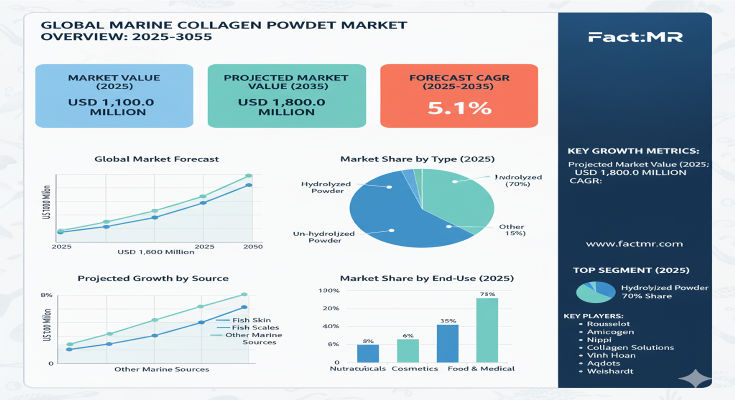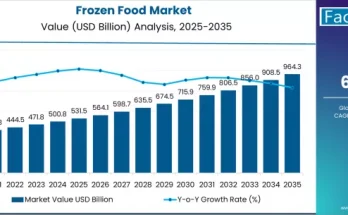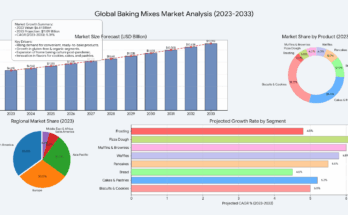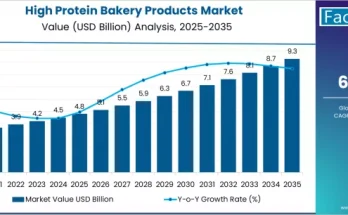The global marine collagen ingredients market is projected to grow from USD 1,700 million in 2025 to USD 2,900 million by 2035, registering a compound annual growth rate (CAGR) of 5.4% over the forecast period. This growth highlights the rising appeal of marine-derived collagen as a premium ingredient in nutraceuticals, cosmetics, functional foods, and other wellness applications — driven by demands for natural sourcing, high bioavailability, and clean-label credentials.
Market Drivers & Growth Catalysts
Several factors are fueling expansion. Consumers increasingly favor natural and sustainably sourced ingredients, and marine collagen extracts benefit from fish by-products (skin, scales, bones, etc.) that are being upcycled into value-added ingredient streams. This not only supports sustainability narratives but also helps manufacturers reduce waste by valorizing marine industry by-products. In addition, improved extraction techniques and purification technologies are delivering higher purity and better functional performance, enabling manufacturers to integrate marine collagen peptides in premium formulations that demand consistent quality and efficacy. The growing interest in wellness, anti-aging skincare, joint & bone health supplements, and beauty-from-within nutrition is pushing demand for marine collagen across multiple applications.
Click Here for Sample Report Before Buying: https://www.factmr.com/connectus/sample?flag=S&rep_id=8706
Product / Source & Application Segmentation
Marine collagen ingredients are sourced primarily from fish skin, but also from other marine sources such as bones or tendons. Among the sources, fish skin is expected to dominate the market due to its favorable yield, collagen content and ease of extraction, making it a preferred raw material for high-purity peptide production. In terms of application, nutraceuticals or dietary supplement segments hold a leading position, capturing a large share of demand as consumers incorporate marine collagen in protein powders, capsules, drinkables and functional foods. Other key application fields include cosmetics / personal care formulations (skins, anti-aging, beauty wellness) and functional foods or beverages addressing wellness, nutrition or beauty applications.
Regional Outlook & Growth Opportunities
Regions such as Asia-Pacific, Europe, and North America are leading growth markets for marine collagen ingredients. Asia-Pacific is particularly promising due to robust marine raw material availability, growing consumption in wellness and beauty markets, and increasing consumer focus on clean label and nutraceutical products. Europe and North America continue to adopt premium marine collagen ingredients driven by strong consumer demand for natural beauty, wellness supplements, and premium functional foods or beverages. Emerging markets in Latin America and Middle East & Africa also represent opportunities as awareness of collagen benefits and demand for premium ingredients grow.
Competitive Landscape & Strategic Trends
Key ingredient suppliers and manufacturers are focusing on improving extraction, refining, and purification processes to produce high-quality, standardized marine collagen peptides or hydrolysates. Many firms are investing in ensuring traceability of raw material sourcing (fish by-products), increasing transparency in supply chains, and obtaining sustainability certifications to appeal to eco-conscious consumers and regulatory requirements. There are also collaborations between marine collagen producers and nutrition, cosmetics or dietary supplement brands to develop novel formulations tailored to specific target markets.
Challenges & Market Constraints
Despite the favorable outlook, several constraints remain. Raw material supply can be subject to fluctuations in fish catch, seasonal availability, or regulatory fishing quotas, which may impact cost and consistency of raw material. The extraction and purification process requires technical expertise and investment in specialized equipment, which can raise costs for smaller processors. Regulatory frameworks vary by region, particularly for claims made on dietary supplements or cosmetic benefits, which can slow market entry or product approvals. Premium positioning also means that in cost-sensitive markets, uptake may be slower.
Forecast & Strategic Recommendations
With growth projected from USD 1,700 million in 2025 to USD 2,900 million in 2035, the marine collagen ingredients market offers substantial opportunity. Ingredient suppliers should focus on scaling extraction capabilities, improving yield and purity of collagen peptides, and developing formulations optimized for different application segments (nutraceutical, functional foods, cosmetics). Expanding production in raw-material rich regions like Asia-Pacific and establishing regional processing or compounding can help control costs and improve supply reliability. Collaborating with downstream formulators to develop targeted wellness or beauty products will help accelerate adoption.
Browse Full Report: https://www.factmr.com/report/marine-collagen-powder-market
Editorial Perspective
Marine collagen has evolved from a niche ingredient into a key premium bioactive material with strong appeal in wellness, beauty, and functional nutrition. As consumers increasingly favor natural, sustainably sourced, and high-bioavailability ingredients, marine collagen is well positioned to become a staple in nutraceutical, functional food, and cosmetic formulations. Ingredient companies that optimize extraction, ensure sustainability and partner with end-use brands will likely lead this space in the coming decade, as the market is set to approach USD 2,900 million by 2035.



